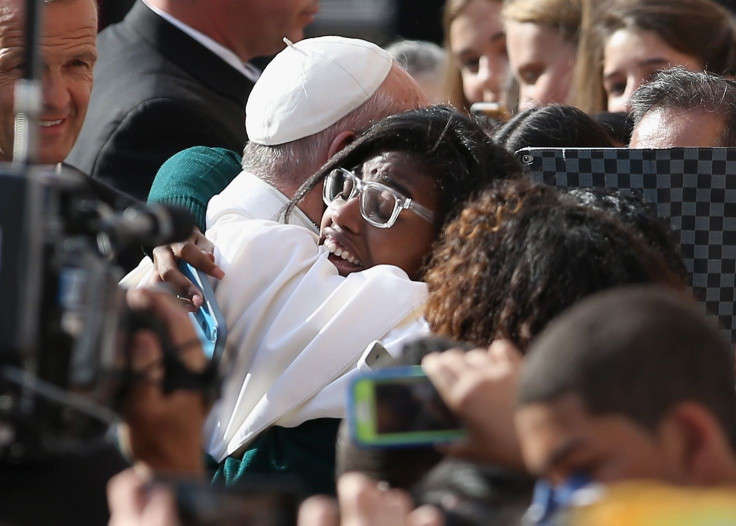Pope Visit 2015: Catholic Schools' Enrollment Trends Paint Bleak Picture

Thirty-two students at St. Genevieve High School in Panorama City, California, are taking a social studies class this year with one goal: "To affect state policy on funding for schools like ours," said principal Dan Horn. The juniors will learn how decisions are made about vouchers and education tax credits -- and try to get them so their school can survive.
Funding issues are never far below the surface even at the most successful American Catholic schools, which have been devastated by huge enrollment declines in recent years. Schools lucky enough to stay open have been forced to scale back and innovate in an attempt to keep up with shifting demographics, high tuition costs and a boom in school choice options. But experts say they're optimistic that their efforts to become more accessible can begin to reverse the trend. And having Pope Francis' support doesn't hurt, either.
During his historic visit to the United States this week, Francis visited the Catholic school Our Lady Queen of Angels in the East Harlem section of New York City. The school, which serves mainly black and Hispanic children, is run by a nonprofit called the Partnership for Inner-City Education. The church its name comes from closed in 2007.
The pope's decision to tour the institution Friday was his way of making a statement about the value of Catholic education, said the Rev. Tim Scully, the co-founder of the Alliance for Catholic Education at the University of Notre Dame in Indiana. "He wants to point to one civic asset that serves a sacred purpose and that works," Scully said. "He can exhort all of us to take a close look at faith-based and Catholic schools."
The Catholic Church has lost up to 3 million members since 2007 and Catholic schools have suffered as a result. In the early 1960s, there were more than 5.2 million students attending 13,000 Catholic schools, but those numbers started dropping in the 1970s. Enrollment rose briefly between 1990 and 2000 before a wave of school closings. In the past 10 years, one-fifth of all Catholic schools in the U.S. closed or merged with another, according to the National Catholic Educational Association in Arlington, Virginia. Enrollment today includes about 1.9 million kids at 6,500 schools.
Andy Smarick, who works with the nonprofit Bellwether Education Partners in Boston, said the drop can be attributed to a growing number of options for parents and children. Whereas 50 years ago parents simply sent their kids to the neighborhood public school, now they can choose from those, charter schools, magnet programs, online classes or faith-based institutions, he said. For decades, Catholic education wasn't keeping up -- they were still viewed as hierarchal, static and stuffy. They've only recently begun to modernize, Smarick said.
The Archdiocese of Cincinnati hired Jim Rigg as superintendent in 2010 to figure out how to do that. It had to close or consolidate 22 schools, and it was losing about 1,200 students a year, Rigg said. But the numbers have stabilized since he implemented a series of initiatives, among them a blended learning program where students spend about 30 percent of their time working at their own pace on individual computers.
He also expanded the school system's financial aid options. Tuition at private Catholic schools averages about $7,000 a year. "We know that the No. 1 reason why families don't come to our schools is because they cannot afford the cost of tuition," Rigg said. "All families, regardless of economic background, should be able to access the quality of education that we provide."
That's part of principal Horn's philosophy in California, as well. About 70 percent of his high schoolers get some sort of financial aid to afford tuition. Though this is important to keep enrollment steady, it's difficult to sustain, he said. Horn said he had to freeze teacher salaries this year and worries the school itself won't exist 10 years from now without a strong endowment.
He said he's hoping the state government implements a voucher system, in which parents can take state money apportioned for their kids' public education and use it to pay tuition at private schools, or education tax credits -- hence the social studies elective. "People love what we do," Horn said, listing the steps he's taken to modernize his school, like offering hacky sack classes and adding a cafe. "The sad part of it is, without a doubt, we are an endangered species."
Listening to a story on @npratc about Catholic schools and churches closing, still hurts years after my own school and church "consolidated"
— Caitlin Vitale (@CaitlinVitale) September 14, 2015In some places, though, administrators have stopped the bleeding. Archdiocese of Chicago interim superintendent Mary Kearney said at least one of her schools has a waiting list to get in after a few campuses were merged and they introduced a focus on STEM fields -- science, technology, engineering and math. Despite the challenges, she said she's hopeful about the future of Catholic education.
"There's some element of reinventing ourselves for the 21st century, but I think think Catholic schools are up to the task," Kearney said.
© Copyright IBTimes 2024. All rights reserved.






















